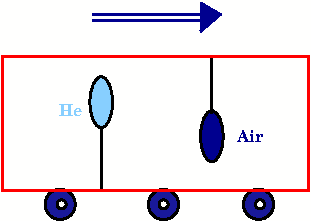Prerequisites
Newton's laws of motion; Some elementary ideas about inertial and non-inertial frames.
Lesson Goals
- To relate accelerations of a body as seen by an observer in an inertial frame and a non inertial frame. There are two cases of interest. These are as follows.
- To obtain equation of motion in a linearly accelerated frame;
- To obtain equation of motion in a rotating frame, and to obtain expressions for centrifugal and Coriolis forces.
Only case (a) will be taken up in this lesson - To explain gravitational and inertial masses.
- To explain equivalence principle
\(\S2\) Examples of Accelerated Systems
\(\S3\) Gravitational and Inertial Masses ;
\(\S4\) Pseudoforce vs Gravitational Force; Equivalence Principle
EndNotes
One might be tempted to ask what is the frame of reference w.r.t. which the acceleration is being measured. The answer is very simple the acceleration is w.r.t. an inertial frame, and independent of the inertial frame we may have in mind.
Food For Your Thought
|
A cart carries an air balloon suspended from ceiling and a He filled balloon tied to the floor. The figure shows the situation when the cart is moving with uniform velocity. How will the two balloons appear when the cart has an non zero acceleration in the forward direction indicated in the figure by an arrow?
|
 |
 |
|
Further Reading
- Several experiments have been performed to verify equality of inertial and gravitational masses. Galileo's famous experiment (1589-92), of dropping different objects from leaning tower of Pisa, demonstrates just this. Learn more about Pisa tower experiment.
- In 1889, the Hungarian physicist Roland Et\"{o}v\"{o}s used a slightly different approach to verify the equivalence of gravitational and inertial mass for various substances to an accuracy of about \(10^{-8}\), and the best such experiment improved on even this phenomenal accuracy, bringing it to the \(10^{-12}\) level accuracy. Click to learn more about experimental verification of equivalence.
- This equality is formulated as equivalence principle which is an important principle for general relativity. Click to know more about weak and strong forms of equivalence principle.Click to learn more about this equivalence. See Also
- Weinberg discusses inertial and gravitational masses, Et\"{o}v\"{o}s experiment and role of equivalence principle in general relativity.
Watch A Video
Equality of inertial and gravitational masses has been tested to great accuracy. Here is video demonstration of equality of inertial and gravitational masses. An experiment involving a feather and a ball was performed in a big hall A feather and a ball are dropped from same height. The ball reaches the floor first, the feather takes much longer. This difference in time of free fall is attributed to large air friction acting on the feather. The same experiment is repeated in the hall after evacuating the hall. Brian Cox visits NASAs Space Power Facility in Ohio to see what happens when a bowling ball and a feather are dropped together under the conditions of outer space. The result is for you to see.
| Watch the video on YouTube | Watch the video on BBC site |
me-lsn-08001
Exclude node summary :
Exclude node links:
4727:Diamond Point






 ||Message]
||Message]
